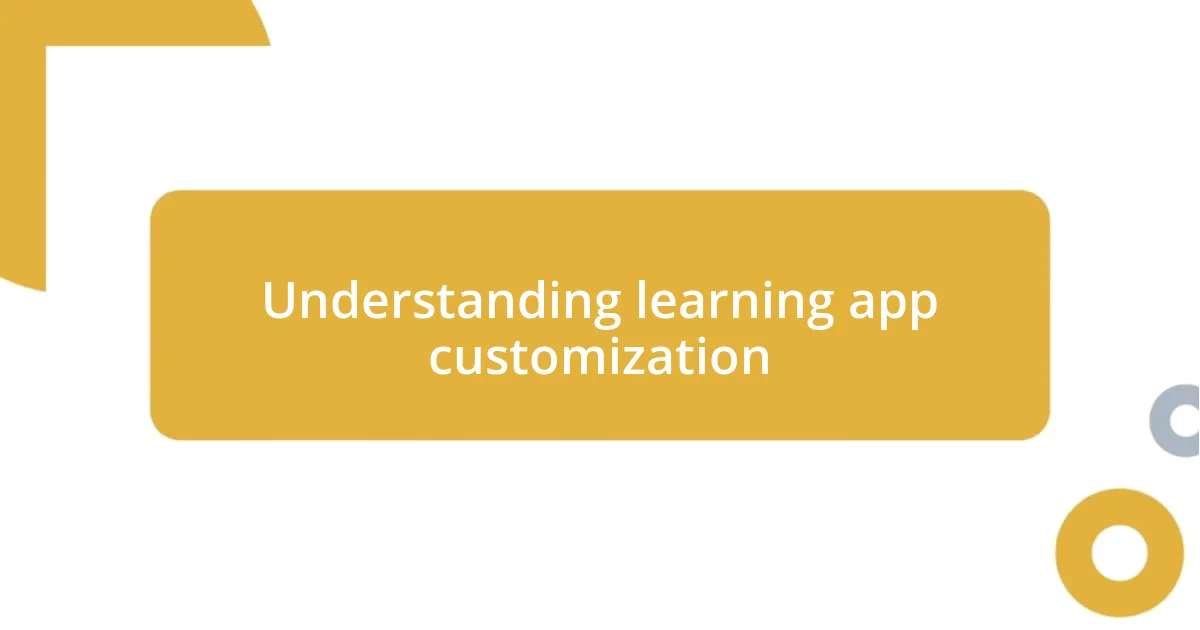Key takeaways:
- Customization of learning apps significantly enhances user engagement and retention by tailoring content to individual preferences and learning styles.
- Key features for effective learning apps include intuitive user interface design, adaptive learning paths, and social interaction elements to foster community and collaboration.
- Successful case studies demonstrate that personalized learning approaches lead to improved engagement and educational outcomes in various settings, including schools and corporate training programs.

Understanding learning app customization
Customization of learning apps is about tailoring the experience to fit individual needs. I remember when I first used an educational app that allowed me to adjust the difficulty level based on my progress. It felt empowering—like having a personal tutor right at my fingertips! Have you ever wished that your learning experience could adapt to your pace and style?
The importance of personalization can’t be overstated. When I explored a few learning platforms, I noticed how much more engaged I became when I could select topics that truly interest me. Why settle for a one-size-fits-all approach when you can create a learning journey that resonates with your passions? Isn’t it fascinating how a little bit of customization can transform motivation and retention?
Moreover, integrating elements like gamification and feedback loops can significantly enhance the learning process. I’ve seen how incorporating small rewards for completed tasks makes the experience enjoyable and encourages continual engagement. Wouldn’t you agree that learning should be as rewarding as it is informative?

Benefits of customizing learning apps
Customizing learning apps offers a range of benefits that can profoundly impact the educational journey. One standout advantage is enhanced engagement. When I adjusted a learning app to align with my preferences, I felt an immediate boost in my enthusiasm. It was as if the app was speaking my language! Engaging with content that truly resonates increases the likelihood of retaining information and enjoying the learning process.
- Tailored content improves motivation and focus.
- Users can progress at their own pace, reducing frustration.
- Customization fosters confidence by allowing users to tackle challenges suited to their skill level.
- Incorporating varied learning styles ensures a deeper understanding of materials.
- Personalization creates a sense of ownership over the learning experience, making it more fulfilling.
Another benefit lies in the adaptability of learning apps to different contexts. I’ve had moments when I needed quick reviews while commuting. My customized app allowed me to choose bite-sized lessons that fit into my busy schedule. It’s incredible how adapting learning opportunities to daily life can make education feel seamless, rather than a chore.

Key features to consider
When considering key features for customizing learning apps, user interface (UI) design stands out as a priority. I remember the first time I encountered an app with a clean, intuitive layout. I felt like I was navigating a familiar space, which made the learning experience feel more enjoyable. It’s essential that users can easily find what they need without any confusion. If an app is visually cluttered, it can detract from the learning experience, leading to frustration instead of engagement.
Another important feature is the ability to provide adaptive learning paths. Reflecting on my own experiences, I appreciate when an app adjusts its curriculum based on my performance. It’s like having a coach who knows exactly when to challenge me or when to offer support. This adaptability not only keeps the learning process aligned with my needs but also nurtures a sense of progress and accomplishment. Wouldn’t you agree that feeling supported in your learning journey can make all the difference?
Lastly, incorporating social features, like peer reviews or discussion forums, can significantly enhance the learning experience. I’ve found that sharing insights and asking questions within a community fosters deeper understanding and retention. Whenever I engage in discussions with peers through an app, it adds a collaborative element that enriches my learning. It’s not just about acquiring knowledge; it’s also about sharing ideas and growing together.
| Feature | Description |
|---|---|
| User Interface (UI) Design | Intuitive navigation enhances the learning experience, promoting engagement. |
| Adaptive Learning Paths | Tailors the curriculum based on user performance for personalized progress. |
| Social Features | Encourages community interaction and collaboration for deeper learning. |

User experience and engagement strategies
User experience hinges on intuitive design and seamless navigation. I remember downloading an educational app that was so easy to use that I found myself diving straight into the learning content without hesitation. It makes you wonder: isn’t it fascinating how a simple, user-friendly design can create excitement about learning? By eliminating unnecessary barriers, users feel more empowered to explore and engage with educational material.
Engagement strategies can also tap into gamification elements. For instance, I once used an app that rewarded me with badges for completing lessons. This really motivated me to keep going, almost like a friendly competition with myself. Have you ever experienced that rush of accomplishment from achieving small milestones? That sense of progression can be incredibly rewarding and encourages continuous interaction with the app, making learning feel more like a game than a task.
Moreover, incorporating personalized feedback is crucial for fostering engagement. When I received instant feedback on my quiz answers, it felt like having a mentor right at my side. This immediate response made me eager to improve and understand where I needed to focus. Wouldn’t you agree that personalized insights could motivate a learner to strive for better results? Tailoring these experiences keeps the user invested and encourages them to reach for higher standards.

Tools for developing customized apps
When it comes to tools for developing customized apps, there are some fantastic options available today. For instance, I’ve had the chance to experiment with no-code platforms like Bubble and Glide. These tools empower anyone, even those without programming skills, to create functional apps quickly. Isn’t it exciting to think that with just a few clicks, you can bring your app concept to life?
On the more technical side, frameworks like React Native and Flutter have significantly changed how developers approach mobile app development. When I first tried out Flutter, I was blown away by how it allows you to create visually stunning interfaces while also being efficient. It felt like having the best of both worlds—great design and high performance. Have you ever worked on a project where the tools made all the difference in your experience?
Furthermore, using analytics tools like Google Analytics or Mixpanel can provide invaluable insights into user behavior. I remember implementing user tracking in one of my projects, which helped me identify exactly where learners were getting stuck. This data-driven approach not only informed my design choices but also gave me a sense of fulfillment to see how small tweaks could enhance the learning journey. Can you envision the potential of using user data to create an app that truly resonates with its audience?

Case studies of successful implementations
One compelling case study that stands out is the implementation of a customizable learning app in a local high school. The educators tailored the app’s curriculum to align with their teaching styles and student needs. I recall attending a presentation where a teacher shared how their students’ engagement doubled within just a few weeks. Isn’t it amazing how adjusting content to fit individual preferences can lead to such significant improvements?
Another noteworthy example comes from a corporate training program that integrated a personalized learning app. The organization opted for a modular approach, allowing employees to select courses relevant to their career paths. I remember chatting with a participant who felt like they had more ownership over their development, leading to higher completion rates. Have you ever felt a similar connection when learning something that truly resonates with your personal goals?
In a completely different sector, a nonprofit launched an app designed for adult learners in underserved communities. By customizing the user interface to be more intuitive and incorporating culturally relevant content, they witnessed a remarkable increase in daily active users. I was genuinely moved when the project manager shared the impact: adults who previously hesitated to engage with education were now excited to participate. Doesn’t it inspire you to see how thoughtful design can transform lives?











